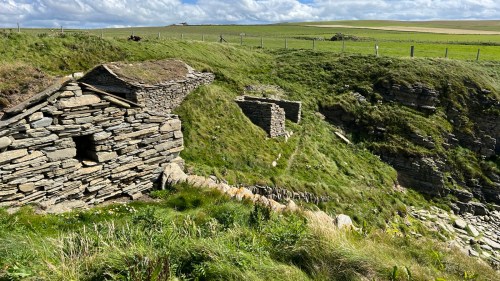Another day, another coastal walk as we make our way slowly south along the west coast of mainland Orkney. There’s so much to see, so many breathtaking seaside parkups, that if we go ten miles in a day it’s a lot.

We had a choice between an uphill hike to the Kitchener Memorial or a level amble to some stone fishermen’s huts. Our knees made the choice. Level.

The huts are over 100 years old, built of stone with driftwood beams supporting the doorways. They provided shelter and housed fishing equipment. You can also see the carved indentations called nousts that cradled the boats during the winter months.


We wished we’d brought a picnic because it was beautiful to sit in a doorway overlooking the sea on another gift of a sunny day.

A few more miles down the road and we staged ourselves at another perfect parkup within sight of our next day’s destination, the UNESCO World Heritage Site, Skara Brae.

Skara Brae might be the only thing many people know about Orkney. Certainly I’ve known about it forever, but after visiting Jarlshof in Shetland and Broch of Gurness a few days ago I wasn’t expecting much. Add to that a sudden turn of the weather with strong winds and a drop in temperature and my enthusiasm for poking around another pile of rocks on a windy coastline had waned considerably. Still, it’s a near complete Neolithic settlement, older than Stonehenge and the Great Pyramids of Giza, so we can’t skip it.
In the event it turned out to be an informative visit. Between the visitors center and the archaeological site they’ve built a replica house to give you an idea of what life was like in Orkney 5000 years ago.


Skara Brae was like the Levittown of the Stone Age. Each house was nearly identical, with a central entrance, wife’s bed on the left, husband’s on the right, dresser on the back wall, fire pit in the middle. It was cozy in the replica, out of the wind, and you can imagine it being warm and dry with a fire going. Except for the lack of indoor plumbing and a strong cell signal it didn’t seem a bad way to live.

Out on the site the wind was blowing a hoolie.
There’s no free audio tour like the one that so enhanced Jarlshof, but there are several docents stationed around the very compact site to answer any questions, and after a walk around the perimeter I had a list.

While Jack meandered back and forth taking photographs I cornered one of the guides and peppered him with questions.
What were the roofs made of? We don’t know.
Why did they leave? We don’t know.
Did they burn peat? No, there wasn’t peat that far back. We suspect dried seaweed and animal dung.


How many people lived here? We think about 40.
Were the people under threat of attack from outsiders? No, these settlements have no defensive structures and we believe there was commerce or communications among the settlements.
I continued to ask questions until I noticed a few other visitors waiting patiently for their own quality time with the docent and I thanked him and went searching for Jack, who never seems to tire of photographing rocks, especially by the seaside.



Eventually the wind and the chill sent us scurrying back to Escape Velocity.
Skara Brae is different from the other Neolithic sites we’ve visited in that it was built and occupied in the one Stone Age period. Jarlshof and Broch of Gurness had successive occupations during the Iron Age, then by the Picts, the Vikings, and so on. Skara Brae is a valuable resource for archaeologists but I’m still saddened by how much knowledge gets lost over the millennia.
After a couple of days of human history and archaeology we’re looking forward to some natural history for a change. Tomorrow.
